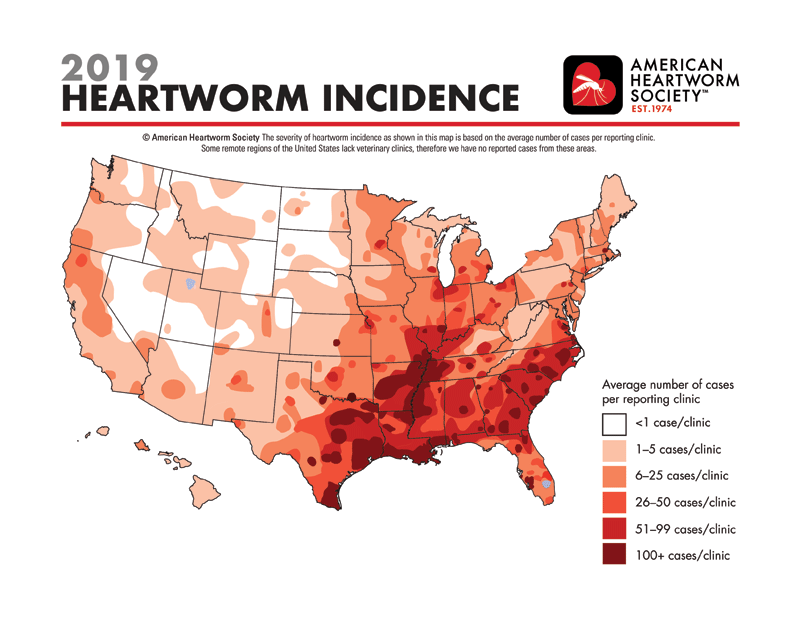
One of the most insidious parasitic infections in dogs is heartworm. If unchecked, the parasite, Dirofilaria immitis, wreaks havoc in the dog’s heart, lungs, and arteries, often resulting in death. Spread by mosquitos, dirofilariasis or heartworm, is found around the world.
Although dirofilariasis is common and potentially fatal, it is also one of the easiest infections to prevent.
“Heartworm prevention has never been more convenient or more affordable,” says Jenni Rizzo, DVM, president of the American Heartworm Society (AHS) an organization dedicated to research and education on heartworm disease in pets.
“Veterinarians and pet clients can now choose from more than 20 different heartworm preventative products for dogs and at least seven preventatives for cats that are administered monthly, semiannually, or annually,” says Dr. Rizzo.
Oral, topical, and injectable preventatives, and combination products now available in the market, enable clients to protect their pets from heartworm, as well as fleas, ticks, mites, and other intestinal parasites. A recent increase in the availability of generic medications has also made heartworm prevention even more affordable for clients, according to Rizzo.
“No matter where you practice in the U.S., the exposure a particular pet has to specific parasites, and the unique circumstances of a particular household, there’s truly an option to fit every need,” says Rizzo. “Heartworm preventatives are more convenient and affordable than they’ve ever been, and educational resources are more abundant and accessible. As long as researchers continue to innovate, and the profession continues to advocate for patients, veterinarians will be in a strong position to improve heartworm compliance and reduce disease prevalence,” she adds.
More heartworm
Despite effective medications that are affordable and easy to administer, the prevalence of heartworm is going up, according to Rizzo, for multiple reasons.
- Increased testing. The more the veterinary community tests for heartworm, the more cases will be uncovered. Highly accurate and easy-to-use antigen tests for heartworms in dogs are recommended annually by the AHS—including for dogs that are on year-round prevention. Not only does routine testing detect heartworm in dogs that have not been on prevention (such as a newly adopted dog with an unknown health history), it also identifies those that may have become infected due to compliance lapses.
- Reservoirs for disease. Millions of dogs, including both homeless and owned dogs, receive little or no veterinary care, according to Rizzo. Heartworm preventatives are available by prescription only, so dogs without regular medical care go unprotected. These unprotected dogs are prime candidates for both infection and propagating the spread of heartworms to other pets. Wild canids are also susceptible to heartworm infection and can serve as a reservoir for infection to dogs and cats in the area.
“When you consider the growing numbers of coyotes that have moved into urban and suburban areas, the threat they pose is clear,” says Rizzo.
- Year-round. In the past, many veterinarians treated heartworm as a warm-weather concern that only required prevention from late spring through early fall. However, it can be nearly impossible to predict when heartworm transmission may happen, given the effects of climate change, the unpredictability of weather, and the existence of man-made warm microclimates indoors and around heated buildings, according to Rizzo.
“Pets are also traveling with greater frequency than ever before, as vacation destinations become more pet-friendly, and more families opt to bring their dogs on trips,” she says. “The transport of infected rescue pets may also impact heartworm activity at all times of the year. For these reasons, the AHS recommends year-round prevention.”
Educating clients
To address the increased prevalence of heartworm disease, Dr. Rizzo recommends tailoring preventatives to pet owners, and helping educate them about the importance of keeping heartworm at bay.
“While all FDA-approved heartworm preventatives are effective, there is no one-size-fits-all heartworm preventive recommendation for clients,” Rizzo says. “When recommending heartworm prevention to clients, it’s vital to investigate factors such as preferences (Does the pet do better with chewable, injectable, or spot-on medications?), lifestyle (Is the client a busy mom or a doting retiree?), regional health risks (What other parasites are critical to prevent in your area), and budget (Does the household have multiple pets? What can they afford?).”
Educating pet owners about heartworm also needs to be a team effort at the veterinary hospital.
“From the front desk to the exam room nurse, to the DVM, everyone needs to feel comfortable talking to clients about heartworms,” says Rizzo. “Anyone should be able to answer simple questions, such as where do heartworms come from, how do you test for them, and why is prevention important.”
Since clients often refer to an entire veterinary practice as “the vet” and may lump conversations with multiple staff members into a single memory of what “the vet” recommends, each member of the hospital should deliver the same confident guidance.
Encouraging pet owners to take heartworm seriously is a crucial part of combatting this disease and explaining the threat of heartworms in ways the client can clearly understand is the first step.
“I like to make the disease relatable for clients by putting them in their pets’ situation,” says Rizzo.
“I might say, ‘Imagine how it would feel if you had 12-in. worms crawling around in your lungs? Just the thought of it is probably horrifying,’ or ‘Have you ever been through a time when you felt perpetually tired or out of breath? That’s how dogs with heartworms can feel.’ If we can protect our pets from experiences like this—not to mention potentially saving their lives—we should.”
Getting the message across

Pet owners need to be assured heartworm prevention is affordable. Rizzo recommends telling clients that for approximately the cost of a latte, they can protect their pet against heartworm for a month.
Making prevention convenient is also important, and numerous options are available to tailor treatment to a client’s lifestyle and needs. If clients find monthly prevention hard to remember, they can consider an annual or semi-annual injection of a heartworm preventative.
Sharing personal stories is another suggestion in driving home the point about heartworm prevention, according to Rizzo.
“It’s one thing to talk about the threat of heartworm disease in the abstract,” she says. “It’s another to present it as an issue that is present in a client’s own backyard. You might choose to tell them about a case of heartworm you treated recently—and include details such as what clinical signs your patient suffered or what the treatment ended up costing the client.”
Rizzo recommends referring the client to the latest AHS heartworm incidence map (Figure 1) or a summary from the hospital’s medical records showing how many cases of heartworm infection you have treated in the past year.
Reminding pet owners mosquitoes and the threat they pose are omnipresent is also important.
“Explain the dangers posed by a single heartworm-positive dog in a neighborhood, and that 70 percent of mosquitoes in an infected dog’s immediate vicinity have been shown to be carrying heartworm larvae. Finally, add that there’s no way the client can know which dogs—or coyotes or foxes—in their area are heartworm-positive,” says Rizzo.
It is crucial to keep repeating this message to clients in an effort to make an impression. Rizzo recommends thinking about all the touchpoints you and your staff have with a client during a visit, as well as in between visits, including the reminder message you mail about annual heartworm testing; a social media post on your clinic page about heartworm prevention; a video playing in your waiting room, or a heartworm brochure (See “In the know”). It can also be a question a veterinary technician asks about the annual number of heartworm doses given when taking a patient history, or a poster on the exam room wall explaining the heartworm lifecycle. A confirmation from a front-office staff member that a client has purchased heartworm medication refills before they walk out the door is also important.
“Each of these interactions can contribute up to a unified message from your practice that, in turn, increases your client’s confidence in your recommendation,” says Rizzo.
Audrey Pavia is an award-winning freelance writer who specializes in pet and veterinary topics. She lives in Southern California with a menagerie of dogs, cats, and horses.
